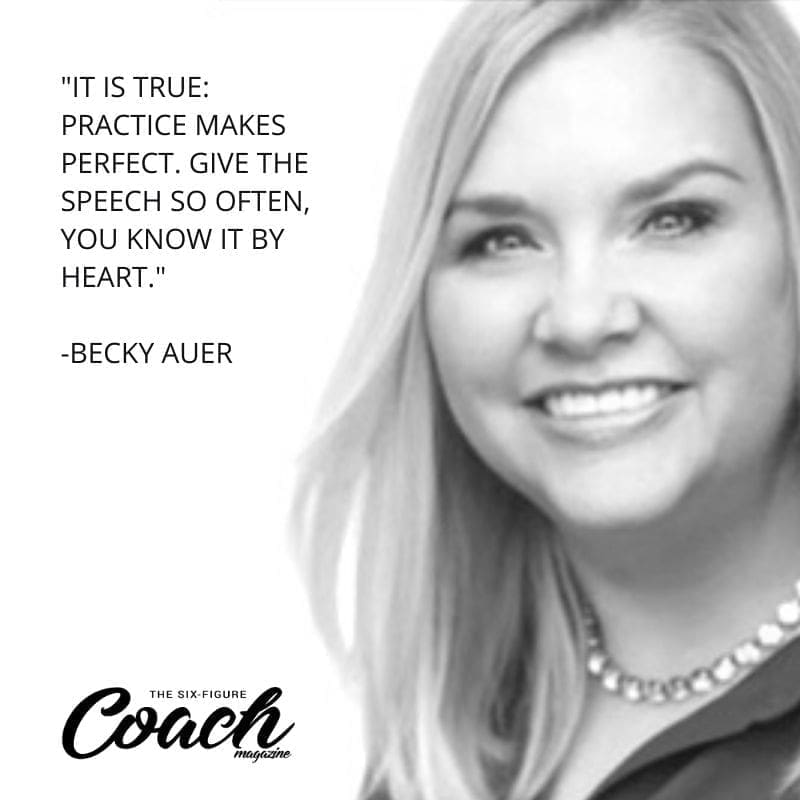How To End Your Fear Of Public Speaking by Becky Auer
End Your Fear Of Public Speaking
Fear of public speaking is a common phobia and one that is believed to affect up to 75% of the population. Some people feel only slight nervousness at the very thought of public speaking, while others experience full-on panic and fear, says Psycom.net.
If you are a coach, public speaking is almost a ‘must’ for success nowadays—and a huge factor in creating a more powerful brand. Those who face their fears and accept or search out speaking engagements are head and shoulders above their competitors in branding, authority, and reach.
Plus, when you speak publicly, it can be an excellent supplement to your income. That could be anywhere from $500 for a new speaker up to $50,000 or more from an influencer!
So, even if you have zero public speaking experience, there is a place for you in this wild world of coaching!
To date, I’ve given over 350 (and counting) seminars, workshops and boot camps, so I’m going to share a couple tips and tricks to get you going!
Of course, I’m not recommending that you jump in cold … you need to prepare. So let’s talk about what’s needed and put together a plan to help you dive into public speaking like a pro, with total confidence!
There are two things you need to do before you can walk into a public speaking engagement without either dying of stage fright or feeling like a fraud. Number one, you need to dip your toe in, wade in slowly and get used to the water; and number two, you need to be able to present yourself as a public speaking pro.
Starting out, we’ll talk about a super shy person with zero experience up to feeling confident and ready. You’re probably somewhere in between, so let’s get started.
Start Locally
If you are shy or an introvert or you socialize only within your comfort zone, then remember that it is okay to start with baby steps. Before even thinking of giving a formal ‘talk,’ your first step is to expand that comfort zone, little by little.
Here are two easy ways to do that.
Online: In a Facebook group, you feel comfortable in, give a one-minute-or-less Facebook Live video on any topic you can talk comfortably about.
And here’s the great part for shy people. When you are practicing on Facebook, there is an option where you can choose “Only Me” —and make a few Facebook Live videos that are for your eyes only. Google it. It’s easy.
When you are comfortable with using Facebook Live, then you can take the next step and choose to share it with more friends and people.
Offline: Commit to speaking to three extra people you don’t know, every time you go out. Do this at church, in the grocery store, in the doctor’s office, and so on.
Now Go Stretch
Yes, you need to stretch out of your comfort zone. Look, we’re all nervous when we get started. Here are a few ways to do that:
Find three new people at a party and start a conversation
Go to a local group or Meetup and do these things to get comfortable:
Ask the speaker a question
Volunteer for any activities that involve standing up, speaking aloud or going to the front (or to the stage)
Introduce yourself to three new people after the presentation
Another thing you can do is volunteer to give that presentation for your local Chamber or present a workshop at your local library or community college.
Outside of workshops, look for other opportunities. For example, volunteer to serve food at your lunch or local event. Serving food is a super-easy way to ensure that you make eye contact and interact with people—even if you’re just saying, “Would you like cream or milk?”
Set goals before you go out to meet with others. When you make up your mind to volunteer during a speaker presentation or workshop, that is two-thirds of the trick to ensuring that you actually do.
And most important: Acknowledge your awesome achievement, every time you take steps towards your goal. Look, you made a step that many people have never tried! They may speak to more people than you, but they stay within their comfort zone. You’ve already stepped way out of yours and the shyer you are, the bigger your achievement! So, don’t allow yourself to hear any negative self-talk or, most certainly, do not compare yourself to any others.
Now you have to keep doing it. Yes, I said it. You must desensitize yourself. This means doing it so many times that it becomes just another part of your comfort zone. I also call this: not caring what other people think!
Be Prepared
Knowing you are well-prepared and have practiced your presentation can give you more confidence than all the pep talks in the world.
Preparing To Give Your Speech
A vital part of speech prep lies in practicing your speech—over and over. The best way to do it, rather than memorizing every single word, is to make a list of key points (or use a stack of 3 x 5 cards). These should be slanted at prompting you to remember what happens next. I used to practice all the time with my cue cards in a mirror.
An example of your cue cards might read:
Thanks for attending
What you’ll learn today
Introduce special guest and mention her something interesting about her
Ask the guest how she got started in her industry
Prompt her on her accident in 2017
Talk about her recovery and journey
When you’re making up your note cards, start with the essential housekeeping items, such as intro, what you’re talking about, what to expect in the speech, and so on. Then jump straight to the ending elements—any calls to action or offers, your website, and contact information.
Put your details in after you’ve listed the absolute housekeeping essentials.
Use your note cards as a loose ‘script’ and highlight or check off each talking point as you complete it.
Soon you won’t even need your cue cards especially if it’s a signature talk you’re giving but this is a great way to make sure you don’t skip any important detail, and you can recover quickly if you ‘freeze.’
So practice your speech everywhere: In the car, during commercials, while you’re watching your tv, curling your hair.
Then practice giving it to a real, live audience. (Start off with your dog! Dogs make fantastic audiences, because they usually love it when you talk to them, turning your whole attention on them.)
It is true: Practice makes perfect. Give the speech so often, you know it by heart. But keep your note cards on hand in case you lose your place.
Physical Prep
When it’s time to give your actual speech, preparation is more critical than ever—whether you are giving your speech online or at an event.
Number one: Get their early—either at your desk or at the venue.
Test microphones and any equipment you are going to use.
Before you leave the house, use an actual checklist to make sure you have everything you need—that’s the best way to avoid suddenly discovering you forgot your thumb drive, your USB cord, or any other piece of equipment.
Pay attention to what you are going to wear. Layout all pieces of your outfit the night before. Allow an extra hour to get ready. Wear layers! From one gal to another (sorry guys), there must be a place to put that microphone box!!! So, a jacket or slacks with a pocket or if you are wearing a dress, throw those Spanx on underneath because the pesky microphone box has to go somewhere!
Develop Your Voice
People seem to hate the sound of their own voice. I know I did.
It’s important to realize that this happens to everybody!
Here’s the truth about public speaking. A few seconds into your speech- especially if you’re focusing on helping your audience rather than your own sound of your voice—you’ll forget how you sound. You’ll be too busy sharing what you are excited about for fear to creep in and stay.
Record yourself. Listen to it objectively and analyze what you need to work on.
Ask Yourself Questions Like…
1. Is my voice confident or quavering?
2. Am I projecting my voice properly?
3. Am I making explosive sounds on consonants like ‘s’ and ‘p’ in the microphone?
4. Do I talk too slowly and put myself to sleep, or do I talk too fast?
5. Has my voice climbed higher out of nervousness? Does it sound squeaky?
6. Do I make annoying repetitive sounds such as ‘Ummm’ or ‘Errr’? Do I have ‘favorite words’ that I keep repeating?
You can eliminate a lot of bad habits right away—but first, you have to realize you have a particular ‘bad habit.’ For example, you may not realize you use the word ‘awesome’ every second sentence, or that you begin every sentence with ‘Uh…’. Or you may notice you speak so quickly you can’t even make out what you’re saying when you hear the playback.
Pro Tip: Join a group like Toastmasters, where you can practice in front of a live audience. I call them the ‘friendlies.’ They are there ONLY to help you hone your practice of public speaking, and they are in every city.
Get That Audience
But what if you’re speaking live instead of online? That’s a whole different kettle of fish, isn’t it? You aren’t staring at a computer screen, but at a whole bunch of real, live people.
Believe me: That can be one of the most energizing -and scary – parts of giving a live presentation! We’ll get to why in a moment, but first, a reminder that you need to check your equipment (or make sure it’s been checked) in live venues too.
So visit the venue ahead of time. Make notes of things to check, like how to adjust the microphone that is too high for you; and who is going to do that. Will the emcee adjust it for you when he introduces you? Is there someone available to show you how to do it yourself?
Is there a light that’s going to shine into your face? Do you need a chair? Is there a water bottle accessible to you in case your throat gets dry?
Most of the time, all of the above are complete non-issues, the day of your presentation, but it’s the unknown that runs through our minds, making us more nervous.
Getting Into Your Comfort Zone Onstage
Start out with deep breathing and slowing down your breathing.
And before you go on, get on a positive mindset. Reframe your brain from “I’m so nervous” to “I’m going to rock this stage when I share how to beat procrastination with people who are here because they need my help!”
Focusing on your audience and their needs—not on your own nervousness—is the best way to know you’re going to give a great speech.
Your Signature Message
One of the best ways I know to calm your public-speaking nerves: Create a signature message that you learn off by heart and can deliver at the drop of a hat, in any situation.
What’s a signature message? It’s one that focuses on your most important message—the one thing above all that you feel is most helpful to your ideal audience.
The best thing about a signature message is that you don’t just give it once. You learn it. You promote it. People love it. You get hired to give it again. And again.
Every time you give your signature message, it gets better. You feed off the reactions from previous occasions, secure in the knowledge—the certainty—that people in your audience are going to love it.
It becomes what you are known for. It brands you. And even one appearance at a major conference bestows top-level authority.
A signature message can also introduce you to unexpected opportunities that also help establish your brand. For example, say you are at a big conference of your peers, and some disaster happens. The organizers are quietly going around, looking for someone who can step in. There you are, ready with your signature message—and you’ve even brought your speaker sheet with you, detailing it, so they can see at a glance how well it’s going to fit.
Not only do you get this excellent opportunity to give your talk (and maybe even get paid to give it), but you score major points being reliable AND memorable as a guest speaker because you were ready, you were there, and you saved the organizer’s back.
Adding public speaking to your coaching is a powerful way to build authority, establish your brand, and maybe even earn some extra money, but you can start as small or as slowly as you like.
And remember, you won’t always be so nervous. Practice really does make perfect.
Need help creating your signature message? Contact me at becky@beckyauer.com!


About Becky Auer
Becky Auer has started 3 multi-million dollar businesses. The last was a Japanese Steakhouse and Sushi Bar that she took from $0 to $6.5M in just over a year and kept it there until she sold it. Becky runs group coaching and mastermind groups as well as coaching private clients. For Free Resources, go to BeckyAuer.com.







